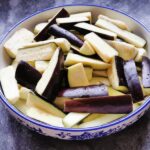Eggplant, or aubergine, is a versatile vegetable with a unique, delicious flavor and a range of health benefits.
Weight Loss and Nutrition
Eggplant is a great source of dietary fiber, which helps with weight control. A high-fiber diet keeps you feeling fuller for longer, reducing the urge to snack. With its low-calorie content, eggplant is an excellent addition to a healthy, balanced diet.
Antioxidant Properties
This vegetable is also packed with phenolic compounds, which act as antioxidants, helping your body eliminate free radicals that can damage cells if they build up. Eggplant also contains flavonoids, which reduce bad cholesterol while increasing the good kind, thus lowering the risk of cardiovascular disease.
Cooking Methods
There are numerous ways to cook eggplant, including stewing, braising, stir-frying, and grilling, each method imparting its unique flavor. However, to ensure the best-tasting dish, it’s essential to start with high-quality ingredients. When buying eggplants, keep the following tips in mind:
– Observe the Shape
You’ll find both straight and curved eggplants in the market. Curved eggplants are generally the better choice, as those grown naturally tend to have a slight curve, and each one will be unique in its curvature. These curved eggplants tend to be tastier and more nutritious.
On the other hand, if you come across eggplants that are perfectly straight and symmetrical, they may have been grown out of season or treated during the growing process to achieve that ideal shape.
– Inspect the Skin and Color

Fresh eggplants typically have a deeper, richer purple color, with a smooth, bright, and evenly colored skin. They should also feel firm to the touch. If you notice significant color variations, a dull or brownish hue, or wrinkled skin, it’s best to avoid those eggplants, as they may have been stored for a long time.
– Check the Stem

At the point where the stem connects to the flesh of the eggplant, you’ll see a white portion. The larger this white area is, the fresher and softer the eggplant, and the sweeter it will taste. Conversely, if this white part is small or purple, it indicates an older eggplant with more seeds, resulting in a less desirable texture and flavor.
– Gentle Press Test
Gently press the skin of the eggplant. If your finger leaves an impression, it means the eggplant is ripe and fresh. However, if the eggplant feels hard, and its color has faded from a vibrant purple to a pale shade, it’s past its prime and best left alone.
Storage and Preparation
Eggplants are best cooked within 24 hours of purchase. Alternatively, wrap them in paper towels and store them in the vegetable drawer of your refrigerator, where they’ll keep for 3-4 days. Avoid sealing them in airtight bags, as this can accelerate spoilage.
When storing eggplants in the fridge, ensure they aren’t stacked under other produce, as their thin skins can easily bruise.
Eggplants are also sensitive to ethylene gas, which is naturally produced by some fruits and vegetables, such as tomatoes, bananas, and watermelons, and can cause other produce to spoil faster. Therefore, avoid storing eggplants near these ethylene-producing items.
Preparation Tips
Before cooking, wash the eggplant thoroughly. You can then cut it lengthwise or into rounds. Sprinkle salt on the cut surfaces and let it rest for 20-30 minutes. This process helps firm up the flesh and reduces any bitterness. After that, use a damp paper towel to wipe away the excess salt, and your eggplant is ready for cooking!
The Ultimate Guide to the “3-Day Cut Oil” Weight Loss Method Taking China by Storm
The 3-day oil-cutting method is gaining traction as an effective weight-loss strategy that doesn’t involve completely sacrificing your favorite foods. Unlike extreme diets that advocate for total deprivation, this method focuses on reducing oil and fat intake for three consecutive days. By minimizing these elements in your diet, your body begins to shed accumulated fat, boosting its fat-burning capabilities without compromising muscle mass.





































